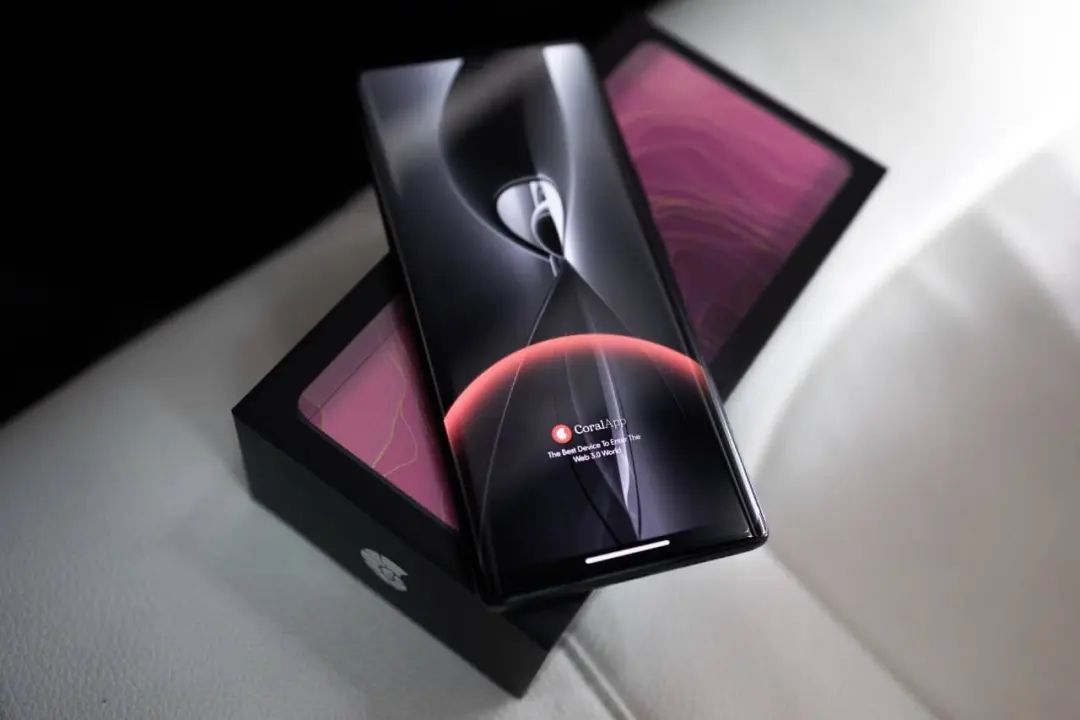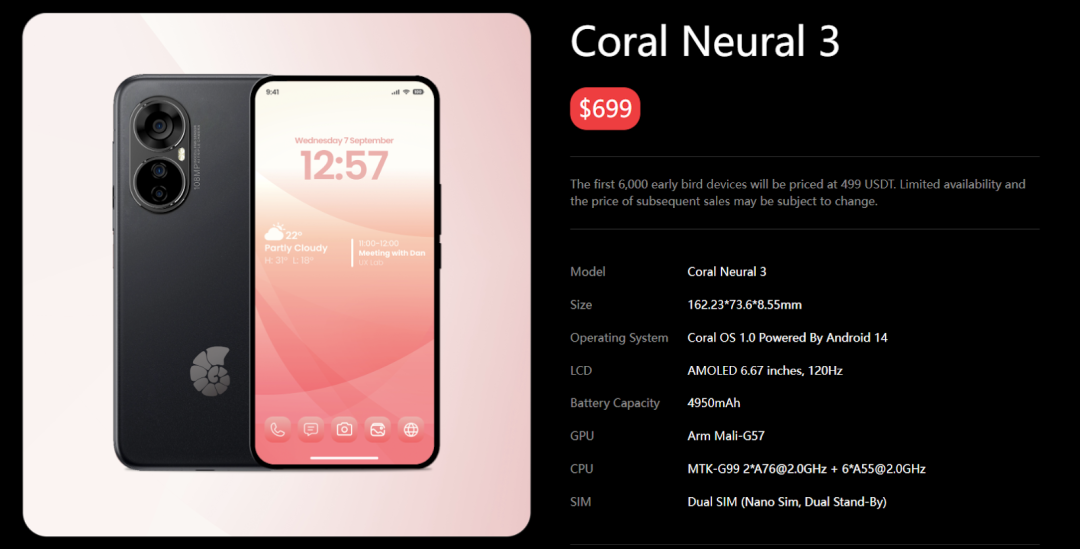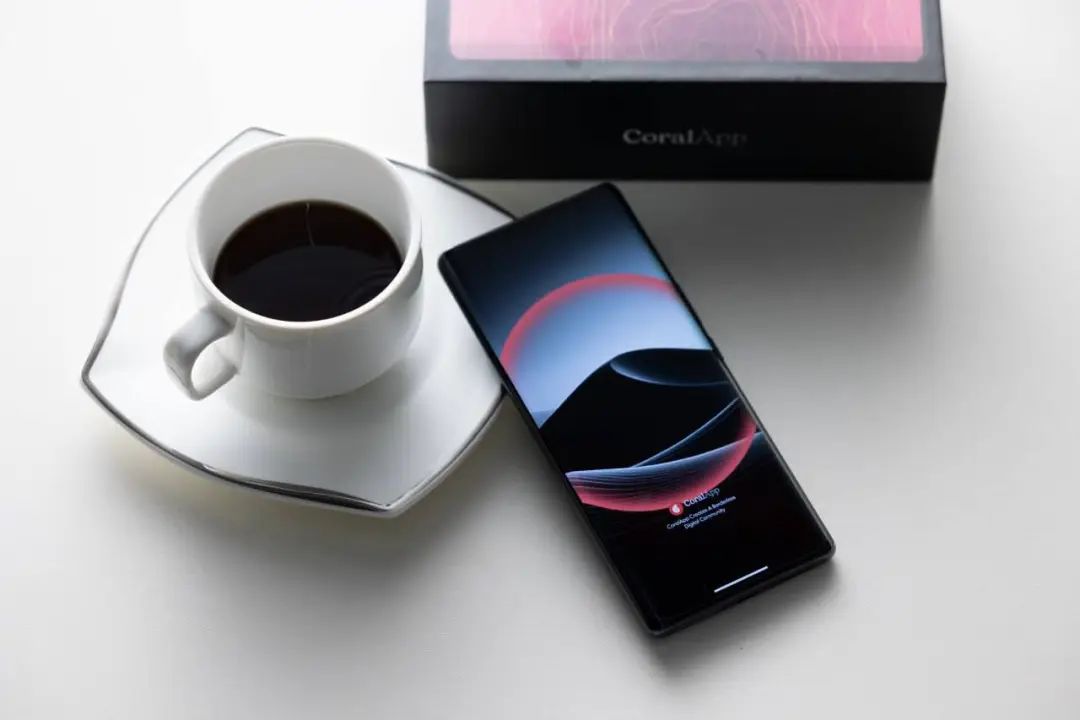Author | Bob
Produced by | Plain Language Blockchain
At the end of last year, the release of the Web3 mobile phone Solana Saga sparked a buying frenzy, and the secondary market premium soared to as high as $15,000. Due to the various rights and interests attached to it far exceeding the value of the device itself, many crypto users who did not participate in the limited sale event regretted missing out.
Recently, CoralApp, invested and incubated by Binance Labs, announced the upcoming limited release of its first Web3 phone, CoralPhone. CoralPhone is not only the first BNB phone, but also the first multi-chain ecosystem aggregator, sparking community discussions: "Is the 'BNB phone' coming? Can it bring a new wave of Web3 phone dividends?"

01. Smart Web3 Entry for Multi-Chain Ecosystem
The Coral Phone, known as the first "AI flagship phone" in the Web3 field, is a dedicated smart phone for Web3 users launched by CoralApp. It will release high, medium, and low-end models tailored to the needs of different countries/regions, using the Android kernel architecture. It will be equipped with a top-level AI chip in the mobile industry, integrating AI-driven technology and DePIN services, bringing new smart hardware and underlying system-level infrastructure to the crypto industry and the entry to the Web3 world.
Based in Dallas, Texas, CoralApp was founded in 2020 and is currently valued at $150 million. It is incubated and invested by Binance Labs, with participation from institutions such as Unicornverse, Gate, Skry Labs, AC Capital, PAKA, and OX Consulting in the first round of investment. The second round of investment institutions is expected to be announced in the fourth quarter of 2024, with the fundraising scale expected to exceed that of the Solana ecosystem phone project, Saga.
Dr. Bunmi Babajide, the founder of CoralApp, has assembled a leading team in the industry, with expertise in both software and hardware services, including a North American internet hardware doctorate and an authoritative expert in Web3 security. They have a reserve of technical talents with original code development and optimization paper patents. In terms of hardware manufacturing, it is the first Web3 phone project to sign ordering agreements with hardware manufacturers in twelve countries worldwide, fully guaranteeing global production, delivery, logistics, and network access services.
As CoralApp is the first project to launch a Web3 phone incubated by Binance Labs, many people habitually regard CoralPhone as the "BNB phone" based on the positioning of the previous Solana phone Saga project. However, CoralApp is actually positioned as hardware and system OS-level Web3 entry that supports multi-chain ecosystems. Currently, CoralApp not only supports the BNB Chain ecosystem, but also has partnerships with over 150 projects in well-known public chain ecosystems such as Solana, Scroll, Swam, and Tap. In addition, future expanding partners will provide diverse benefits and privileges for CoralPhone.
02. What are the Advantages and Benefits of Web3 Dedicated Devices?
Currently, almost everyone has a general-purpose smartphone for accessing Web3 applications. So, why use a Web3 dedicated device? Taking the recent "Black Myth: Wukong" event as an example, due to the high hardware requirements of the AAA masterpiece, many people are struggling with whether to use a general-purpose Windows host or a dedicated device like the PS5 for gaming. The PS5, as a dedicated gaming device, has made significant optimizations in hardware, system, and application platforms. A PS5 with a similar graphics card performance costs around 3000 yuan, while a general-purpose PC configuration costs 6000 to 8000 yuan. Additionally, it requires complex processes such as downloading, installing, and configuring, which is not as smooth as the "out-of-the-box" experience of the PS5.

So far, there are over 400 million crypto users worldwide, and Web3 has become a mainstream industry. The demand for dedicated devices is increasing. Taking the Coral Phone as an example, it can bring at least the following advantages and benefits:
1) Exclusive Ecosystem Dividends from Official and Third-Party Collaborative Projects
Welfare! Welfare! Welfare! This is an important point to emphasize. In the Web3 industry, especially in the new track of super dividends, early participants are all "full of benefits." Currently, due to the high costs required by the upstream and downstream industries in the Web3 phone track, there are few strong players, so early dividends will be relatively concentrated, especially for early bird users. This can be seen from the early users of Solana Saga. As CoralPhone is aimed at multi-chain users and has received extensive cooperation, the corresponding benefits will also be more extensive.
With the imminent release of CoralPhone, early bird users will not only enjoy lower prices but also a wide range of ecological benefits from various cooperative projects. This is because high-quality Web3 projects see the value behind the Web3 phone project and ecosystem: it not only brings new users with low entry barriers, but also serves as a vertical and precise high-net-worth target user "distribution center."
Users willing to spend money to try and test innovative Web3 phones are highly likely to be deeply involved Web3 users sought after by major crypto communities. Additionally, the OS-level Web3 entry will bring many DApp customization optimizations, attention marketing, and other collaborations. Third-party projects will be happy to distribute tokens and other benefits to Web3 phone users.
2) Zero-Threshold Entry User Experience Derived from Underlying Optimizations
In the past few years, the entire crypto community has been exploring scalability, account abstraction, and other measures to reduce entry barriers and improve user experience to enable the large-scale adoption of future Web3 applications.
In fact, even though crypto assets have become mainstream assets today, people have always faced various entry barriers when using Web3 applications on their phones. Take the most basic crypto wallet, platform apps, and "Google Authenticator" app as examples. For Android phones, you need to install Google Play, and for Apple AppStore accounts, you need to change regions. These two seemingly simple operations have actually discouraged most entry-level users. If you say you can just search the internet and download them directly? Well, sorry, viruses and trojans will follow. Many people have had their crypto assets stolen in this way.
When newcomers ask about installing wallets, Google Authenticator, and other operations, it is responsible to say that the complexity of these operations cannot be solved in a few words. At this point, there is an urgent need for a smart phone that is friendly to crypto apps, has a built-in secure encryption chip management for wallets, has an app store for direct downloads without interception, and has prominent reminders for market software and news, providing a zero-threshold entry experience for Web3 users.

3) A More Secure Environment for Web3 APPs and DApps
Because it involves operations such as sending and receiving crypto assets and interacting with the chain, a necessary condition for Web3 dedicated devices is "security." Compared to general-purpose phones, dedicated devices can provide a more secure environment for running and interacting with Web3 apps and DApps.
In simple terms, everyday phones will definitely download a large number of apps provided by different third-party manufacturers and browse various web pages. These apps are constantly requesting various permissions from the operating system, including uploading files, accessing clipboard information, taking screenshots, and viewing albums. Overall, the system operating environment of general-purpose devices is relatively complex, and there are concerns when it comes to asset interactions in Web3 applications.
4) Unleashing the Potential of DePIN and AI
According to the official roadmap of CoralApp, the high-end models of CoralPhone are not only pursuing high configurations in the mobile phone industry but also planning to create smart devices with DePIN services and AI capabilities.
Specifically, in the DePIN track, there is currently a diversity of IoT devices, with high design and equipment costs. Many Web3+AI projects also have special requirements for AI chips. Leveraging its hardware and OS system customization advantages, CoralPhone can be optimized for the DePIN direction and can also function as an IoT device. Additionally, it can introduce the latest AI smart chips to provide corresponding services.
Overall, CoralPhone meets the Web3 entry while advancing towards the future DePIN and AI tracks, using the latest technology hardware for exploration and innovation, encompassing the dividends of both tracks, and unleashing the potential of DePIN and AI.
03. How is CoralPhone Different from Solana Saga?

A horizontal comparison of the two popular Web3 phone projects, CoralPhone and Solana Saga, reveals that compared to Saga, CoralPhone brings more optimizations to the system, applications, and community support, as well as multi-chain benefits. In the future, the diversified models, high, medium, and low-end, will cater to the needs of Web3 users in different countries and regions, making it more user-friendly for entry-level users and more conducive to market expansion.
04. Is CoralPhone Worth the Investment?
Based on the official information available, CoralApp's Web3 dedicated device is quite sincere. It is not just a product in the concept stage with a PowerPoint presentation. Prior to its launch, it has secured upstream and downstream resources, conducted extensive research and development, production, and testing, with significant initial investment. However, users always want to know if CoralPhone is worth the investment. After our analysis, we believe the main points of value are as follows, for your reference:
1) Special Benefits and Dividends
As mentioned earlier, in addition to the ecosystem token of CoralApp's community, it has established partnerships with numerous well-known public chain ecosystem projects such as BNB Chain, Solana, Scroll, Swam, Tap, and more partnerships are continuously expanding. The most significant benefits come from high-quality top-tier projects. Additionally, as a DePIN and AI smart device, it will also be able to mine high-quality projects in the DePIN and AI tracks as a dedicated device. It can be described as an aggregator of multi-chain Web3 hardware dividends that is ready to use out of the box.
2) Hardware Cost-Effectiveness

Currently, from a hardware perspective, it has configurations that are in line with mid-range phones. According to a relevant person from CoralApp, the production cost of the Coral Neural 3 (mid-range) model of CoralPhone is around $300. Considering the substantial investment in software and hardware design and development, the early bird price of $499/original price $699 is quite reasonable.
3) Support from Top Institutional Platform Ecosystem Resources
For projects invested and incubated by Binance Labs, the value lies not only in funding but also in the support of various resources within the vast ecosystem of the world's largest crypto asset platform, Binance. This includes publicity, traffic, and cooperation with high-quality projects.
4) Potential of the BNBChain Ecosystem in a Low Period
It is well known that the BNBChain ecosystem has not performed particularly well in this bull market. The ecosystem has been lackluster, and it urgently needs high-quality projects like CoralAPP to inject new vitality and drive the BNBChain ecosystem out of its low period. Additionally, being the first Web3 phone project to support the almost exclusive position of the BNBChain ecosystem will also bring unique dividends as the BNBChain ecosystem returns to an upward trend.
5) Future Development Prospects
From CoralApp's current layout, it is clear that it aims to focus on Web3 phone software and hardware, focusing on the basic product suite (including Coral Phone, Coral OS, Coral Mobile Stack, and CoralApp), making Web3 hardware devices a new traffic entry point in global markets. It will open up third-party project cooperation, creating a Web3 multi-chain interconnected ecosystem platform based on hardware and underlying OS support.
In essence, it is similar to the Xiaomi ecosystem in the mobile internet industry. Xiaomi focuses on hardware, OS UI, and app store development, and ecosystem platform operation, making the phone a part of the traffic entry point in the mobile internet industry. It then opens up various capabilities and interfaces for third-party project cooperation, ultimately becoming one of the major forces in the mobile internet ecosystem.

05. Conclusion
The upcoming CoralPhone is undoubtedly a strong player in the Web3 phone track. It not only brings new dividend opportunities for users but also provides a new low-threshold entry point for the Web3 industry. By unleashing the potential of DePIN and AI, it is leading Web3 devices onto a new development path, worthy of close attention from the crypto community. Whether CoralAPP can continue to bring more dividends in the future remains to be tested by the market and revealed over time. We look forward to it.
免责声明:本文章仅代表作者个人观点,不代表本平台的立场和观点。本文章仅供信息分享,不构成对任何人的任何投资建议。用户与作者之间的任何争议,与本平台无关。如网页中刊载的文章或图片涉及侵权,请提供相关的权利证明和身份证明发送邮件到support@aicoin.com,本平台相关工作人员将会进行核查。




